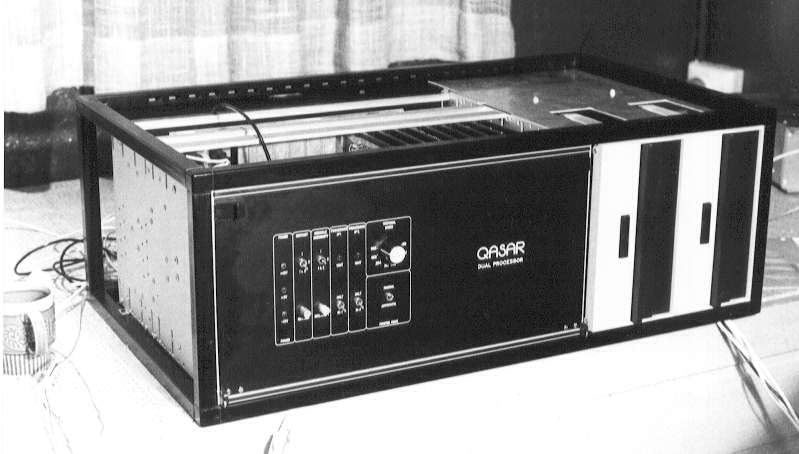SPECIFICATIONS
The Fairlight CMI is based on the architecture of the Qasar M8 (Multimode 8), created by Tony Furse in 1975.
In the early 70’s, Tony Furse, a consulting engineer for Motorola, created his first prototype of hybrid analog/digital synthesizer, the Qasar I.
In 1972-1973, Furse created his second prototype, the Qasar II, with the financial help of both the Federal Government of Australia and Don Banks, composer and director of the Canberra School of Electronic Music.
In 1975, Furse invented his first fully digital, bi-processor synthesizer: the Qasar M8 (Multimode 8), based on the Motorola EXORciser .
- Dual 8-bit 1 Mhz Motorola 6800 processors
- 8 x 20 cm square channel cards = 8 voices of polyphony
- Wire-wrapped boards – no printed circuit board
- 1 bit digital to analog converters (DAC)
- 4 Kb shared RAM with the system and the 8 channel cards.
- Two 8″ floppy drives
- 4 octave keyboard
- Monochrome graphics monitor
- Lightpen
- Additive synthesis with FFT (Fast Fourier Transform)
- Sequencer
- Music notation software
- Dimensions (cm) W x H x D: 100.5 x 44.5 x 46.5
Peter Vogel and Kim Ryrie were also working on the conception of a fully digital synthesizer. When they met Tony Furse, they were impressed by the M8, and decided to buy a licence from Furse, in order to use the conception of his machine.
Although its features and functions were quite impressive for the time, the M8 is a bulky machine oriented towards research rather than the musician.
Vogel and Ryrie’s first job is to reduce the size of the machine and improve the overall concept while retaining the functions of the M8. The components are no longer wired but soldered on printed circuits. The keyboard goes from 4 to 6 octaves with particular attention paid to the quality of the touch. The operating system, the QDOS (Qasar DOS) is an adaptation of the MDOS (Motorola DOS) with full integration of the optical pen for most of the functionalities (navigation, editing, waveform drawing, etc.). This prototype, created under the Fairlight brand in 1976, will be named simply Qasar and will be the basis of the future Fairlight series I and II. In 1978, the sampling function will be added.
PHOTOS
Qasar I
Photo: Tony Furse

Qasar II
Photos: Powerhouse Museum – Sydney, Australie







Qasar II
Photos: Tony Furse



Qasar M8
Photos: Powerhouse Museum – Sydney, Australie





Qasar M8
With Tony Furse

Qasar M8 Boards
Photos and information: Tony Furse
Debug/Control and 6800 Dual CPU boards
These were the first two boards from which Fairlight had Terry Flowers design the PCBs, some two years before Tony Furse licensed Fairlight to have exclusive use of his Qasar and M8 designs in January 1979.
It should be noted that the format of the PCBs chosen by Tony Furse has been adopted by Fairlight for its machines, as well as the techniques for testing the resistance of the components used in the manufacture of the PCBs.
T. Furse’s hand-wired prototypes have been tested to have operational operating temperatures between 0 to 70 degrees. The wires were coated with Teflon to withstand soldering temperatures.




Fairlight Qasar
Photos: Powerhouse Museum – Sydney, Australie


Fairlight Qasar


